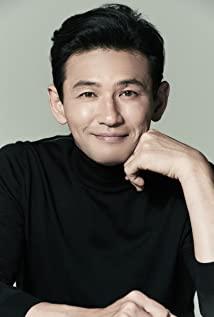The following are some superficial personal opinions expressed by myself after watching the film combined with the director's interview.
The first is the analysis of several superpower key figures.
Japanese:
Devil, chaos maker, the source of all murders and chaos, the existence of devils in Western culture is to create chaos, the essence is evil, whoever catches and harms whoever.
1: At the beginning, the Japanese were fishing and baiting, but the way of baiting was a bit weird (friends who have fished should know that there is no such thing as a hook, there is also this scene in the trailer, and it is also important to put it at the beginning) , which shows that he is not very human, and also indicates the beginning of his evil deeds.
2: Shortly at the beginning, he ate raw venison, and after discovering the witnesses, he showed the image of a red-eyed demon. Why not kill the witnesses here may be the director's arrangement, the plot needs (note, it's not a fantasy or a dream, there are witnesses and deer corpses The fact of the physical evidence was split into a vegetative state by lightning when it was about to be revealed by the witnesses. Whether he did it or not was not explained
. And rumors spread, the film also used short clips to show the Japanese abusing and molesting women.
4: After the second murder case began, after the male protagonist and the Japanese looked at each other, a dramatic conflict appeared, and then the daughter fell ill...
5: The male protagonist went to the Japanese for the second time, this time it was a confrontation, and the male protagonist killed him He killed the evil dog and threatened the Japanese to disappear within a limited time. The conflict further intensified. The next day, he received a warning from the black dead sheep hanging over the door.
6: The most brilliant part of the dance of the gods has begun. It is said to be fighting, but it is not the case. The director's editing arrangement is really clever. The Japanese cast the magic by resurrecting the dead and turning them into zombies to be their servants and ready to fight. Due to the limited ability of demons during the day, And the vicious dog was also killed. The photo of the caster was the zombie himself, so the relationship with Wong Tai Sin was not established. After the white woman appeared, the destruction and suppression of the Japanese caused the Japanese to die in labor pains, which is why the Japanese woke up. Afterwards, I panicked to review whether my spellcasting was successful.
7: Due to the existence of the woman in white, the Japanese faced a lot of pressure. After being pushed off the cliff, they cast a spell in the cave and communicated with Wong Tai Sin for assistance, and implemented a killing plan against the male protagonist's family.
8: At the end of the film, the demon appears to the apostle for the second time, and he recites the bible to show the stigmata. Here, the director creates a double orientation at one time, that is to say, whether it is good or evil depends on your beliefs, but the apostle who is persistent in belief What I see in my eyes is a demon, between gods and demons. Obviously, the devil has the upper hand, which echoes the main theme of the film's opening statement that the director wants to express the crisis of belief.
Wong Tai Sin:
People, wizards, can talk to the spiritual world, greed and deceit, the incarnation of sowing discord, it can also be said to be the darkest side of the human heart, high-sounding, human-faced beast-like, superficially saving people but actually harming others, there are many such things in our lives. People, in the movie setting, it is yin and yang cooperation with the Japanese. The director himself also said that he is in a group with the Japanese. Originally, there was a scene of their communication, but it was deleted later, and only the same underwear and the same photos were selected as echoes. .
1: In the film, Wong Tai Sin took off his coat to reveal the same underwear as the Japanese after his first simple casting.
2: At the end of the film, Wong Tai Sin kept the same photos as the Japanese.
3: Jumping God asks the lion to open his mouth, his purpose is money, to reach a cooperation with the Japanese, if you do evil, I will make money, and constantly repeat the subtext of ghost fishing and bait.
4: In the stage of fighting, most of them will think that they are fighting with the Japanese due to the artistic technique of editing. As mentioned earlier, this is a blindfold method. Both sides of the video show the scene of laboring pains with Huang Taixian knocking on a sledgehammer. The laboring pains of the Japanese are The destruction and suppression of the woman in white, and the pain of Xiaozhen belonged to Huang Daxian. The persecution of Xiaozhen was the real purpose. In the end, at Xiaozhen's request, it was stopped. This is also the illusion of short-term recovery. It is to show that the cooperation with the Japanese Yin and Yang is intertwined and connected with the editing method, which has a certain suspense effect.
5: When Huang Daxian found that all the disadvantages were directed towards the Japanese, especially the Japanese were destroyed by the women in white, chased, killed, and crashed. After a series of disadvantages, he felt that things were not good and he wanted to return to Gucheng to help Japan. After arriving, he was caught by the woman in white and vomited blood and vomited. He was scared to pee. Since Wong Tai Sin is a human being and the woman in white is a god, he could not be killed in the face, so he was warned to stay away from Gucheng. Wong Tai Sin returned home in a panic and was crossed again. The crow attacked and broke the door, and the lights were not turned on. Frightened, she prepared to run away. On the way, the woman in white used the fantasy of crow dung to create a demon. She wanted to use the car accident to kill Wong Tai Sin, but she failed. Wong Tai Sin was recalled by the Japanese here. On the way, he started calling the male protagonist to sow discord.
Woman in White:
God, guardian of order, raven. It is recorded that in Western culture, raven is a prophet, an incarnation of god or a servant. Although the film does not use direct images to describe bad things and good things are done by women in white clothes, but the Japanese are Witnesses saw him appear with red eyes, ate raw venison to leave physical evidence, and abused women. The director deliberately arranged this, which is the difference. The interview also admitted that the setting of the woman in white is a god-like nature, including the actress who also revealed that the role she played was not human.
1: Soon after the movie started, he threw a stone at the male protagonist to give him clues, and dreamed that the Japanese were demons. However, the male protagonist did not realize that this was a supernatural phenomenon at this time and could not actively cooperate with the woman in white.
2: The second time the woman in white appeared outside the Japanese residence, and destroyed his spellcasting, suppressing her, causing the Japanese to experience suspended animation. The film did not eradicate her directly. The plot required it, she died. What else was taken.
3: When the male protagonist and his party were about to have a big fight, they encountered a zombie resurrected by the Japanese on the way. The Japanese checked whether their zombies were resurrected and found and peeked after they came back. As a result, they were rushed by the woman in white and killed the zombies. , rescued the male protagonist and his party, so the Japanese began to escape. As mentioned earlier, the ability of the devil is limited during the day and needs to drink blood to replenish energy, so it will resurrect the zombie to protect itself, otherwise it will be vulnerable, but the annihilation must require God to come out (the actor's innocent performance, and the director's orientation setting There are quite a few misleading, most of them will think that the Japanese killed the zombie, and even start to pity him, why did he kill himself? So, the director deliberately arranged this to make us dizzy)
4: The woman in white and the Japanese started a head-on chase (it is said that there was a fight scene, but the director deleted it for suspense) The Japanese saw that they were about to end, and realized that only Showing that he was a dead body, he crashed a car, in order to confuse the male protagonist and his party into believing that they were human.
5: After the failure to kill the demon, he started to act to save the male protagonist's family and set up traps, but the cunning demon would not be easily fooled. Huang Daxian is bewitched, and the other thing is that the male protagonist has never seen the red-eyed demon, the only thing is dreaming. For ordinary people, the dream is not a reality, but the woman in white instantly grabbed the male protagonist's hand fifteen meters away. This is what he saw with his own eyes. When I saw the woman in white wearing the clothes of a zombie and the daughter's hairpin on the ground, I believed what Wong Tai Sin said, trust eventually turned to the devil, the evil triumphed, and the woman in white shed tears helplessly, a metaphor for the crisis of belief. (This is a path that is difficult for an ordinary person to choose. The male protagonist has the same doubts as the audience. Who should we believe? The director took great pains to make such a proposition.)
6: As for why the woman in white has a card, and The clothes of the deceased have no direct effect on the plot, which can also be understood as a blindfold by the director.
After the analysis, the male protagonist is left. His identity is the same as the audience, an ordinary person. At the end, he is actually not dead. The director said that from the perspective of the film, it will give the audience a little comfort. As a father, husband, son, you, you have worked hard!
The main theme of the film is not to discuss logic, who is good and who is evil, or to explain who is good and bad at a simple level. Obviously this is not the theme of the film. As for how to look and think, the director brings all the elements, questions, and thoughts to the audience without reservation, and that's enough.
View more about The Wailing reviews











